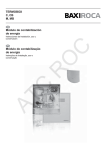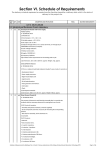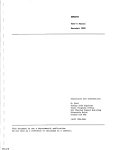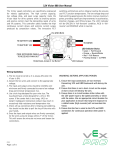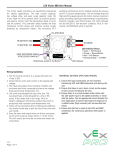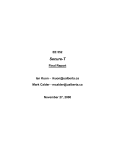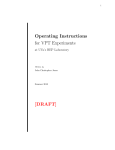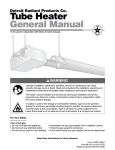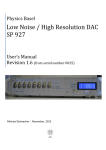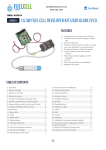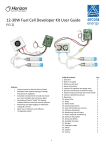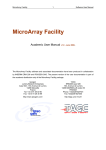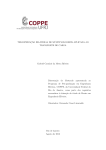Download Untitled - National Instruments
Transcript
Enclosed you will find modern, state of the art education laboratories that are built based on LabVIEW and National Instruments’ Graphical Systems Design technologies. With these labs the students get to learn the fundamental engineering disciplines in an interactive way using modern learning methodologies such as hands-on learning and project-based learning. The labs are designed in a way that the students interact with the real world and bond with technology, and as such develop physical intuition and the understanding of real world constraints. Contact Information National Instruments Arabia Ashrafieh, Sursock St. SASCO Bldg, 4th floor Beirut - Lebanon Phone: +961-1-646 111 Fax: +961-1-646 999 E-mail: [email protected] National Instruments Asia Minor Zincirlikuyu Mah. Kore Şehitleri Cad. Yonca Apt A Blok No.: 1 Kat: 2 Daire: 7 Zincilikuyu - 34394 ŞiŞli. Istanbul Turkey Phone: +90-212-279 3031 Fax: +90-212-270 7974 E-mail : [email protected] National Instruments Egypt 5th District, 90 street North, 47 Bldg Cairo- Egypt Phone: +20-112-190-0003 E-mail: [email protected] National Instruments Saudi Arabia King AbdulAziz Road Port Gate Building - Office 37 P.O.Box 7511 Postal Code : 31472 Dammam - Al Khaldiya Saudi Arabia Phone : +966-3-814 3838 Fax: +966-3-845 1770 E-mail: [email protected] Electronics Engineering Overview Features The laboratory facility for hands-on study of Electronics Engineering is based on the NI Educational Laboratory Virtual Instrumentation Suite (NI ELVIS II) platform used in conjunction with software developed in the LabVIEW graphical programming environment. ▪▪ 22 hands-on experiments in Electronics Engineering ▪▪ Menu-driven navigation through the labs ▪▪ Student registration ▪▪ Interactive representation of circuits in each hands-on project ▪▪ Step-by-step instructions for students ▪▪ Interactive study guide for each experiment ▪▪ Preassembled board with electronic components ▪▪ Representation of experimental results on the screen (graphs, scope signals, numeric indicators) ▪▪ Export of results in MS Excel format All hands-on operations are conducted on the «Electronics Engineering» board. The circuits to be assembled are presented on respective front panels of each hands-on project, as well as in courseware manual. Corresponding sections of the manual are included in lab software so that a student may refresh his memory on appropriate theoretical materials without interrupting practical work on the lab. Experimental results of the lab may be exported and saved in MS Excel format (including student name, date & time, and studied circuit). Electronics Engineering List of labs Required Hardware and Software I. DC circuits ▪▪ Windows XP, Microsoft Office 1. 2. 3. 4. 5. 6. 7. ▪▪ LabVIEW 8.6.1or higher ▪▪ NI ELVIS II platform ▪▪ «22 experiments» board for NI ELVIS II with a set of connection wires ▪▪ Study guide and operations manual ▪▪ PC with monitor Ohm’s law Kirchhoff’s circuit laws Series connection of resistors Parallel connection of resistors Mixed parallel and series connection of resistors DC voltage source in electric circuits DC voltage source in electric circuits II. AC circuits 1. Resistance in AC circuits 2. RL networks in AC circuits 3. RC networks in AC circuits 4. RLC networks in AC circuits 5. Series connection of capacitors 6. Parallel connection of capacitors 7. Series connection of inductors 8. Parallel connection of inductors 9. Voltage resonance in AC circuits 10.Current resonance in AC circuits 11.Inductively coupled circuits 12.Single-phase transformers III. Transient processes 1. Transient processes in linear RL circuits 2. Transient processes in linear RC circuits 3. Transient processes in linear RLC circuits Electronic components on the board ▪▪ Ceramic capacitors: 1 nF, 10 nF, 22 nF, 100nF, 1 μF ▪▪ Inductors: 470 μH, 1mH, 10 mH ▪▪ Resistors: 100 Ω, 200 Ω, 300 Ω, 390 Ω, 510 Ω, 1 kΩ, 10 kΩ ▪▪ Potentiometer: 2 kΩ ▪▪ Single-phase transformer Electronics Engineering Components Overview Features The laboratory facility for study of Electronics Engineering is based on the NI Educational Laboratory Virtual Instrumentation Suite (NI Elvis II) platform and software developed in LabVIEW graphical programming environment. ▪▪ 26 experiments on Electronics Engineering ▪▪ Menu-driven navigation through the labs ▪▪ Student registration ▪▪ Step-by-step instructions for students All operations are conducted on the NI Elvis II prototyping board using special electronics components. The system allows the student to assemble electronic circuits on the prototyping board. The circuits under study are presented on respective front panels of each project, as well as in courseware manual. Course software also contains theoretical materials which can be studied during the lab. ▪▪ Interactive system control during the course of hands-on labs ▪▪ Representation of experimental results on the screen (graphs, scope signals, numeric indicators) ▪▪ Export of results in MS Excel format Experimental results of the lab may be exported and saved in MS Excel format (including student name, date & time, and the studied circuit). ▪▪ Windows 2000/XP/Vista/7, Microsoft Office ▪▪ NI Elvis II platform ▪▪ PC with monitor Required Hardware and Software Electronics Engineering Components List of labs Voltage source in electric circuits I. DC circuits 1. Voltage source in electric circuits 2. Light sensitive resistors (photoresistors) 3. Kirchhoff’s circuit laws 4. Electric power, performance factor, source and load matching 5. Ohm’s law 6. Series connection of resistors 7. Parallel connection of resistors 8. Voltage dividers Kirchhoff’s circuit laws 9. Temperature sensitive resistors (thermistors) 10.Voltage dependent resistors (varistors) 11.Charging and discharging of capacitors II. AC circuits 1. Parallel connection of capacitors 2. Series connection of capacitors 3. AC circuits with capacitors 4. Parallel connection of inductors 5. Series connection of inductors 6. Voltage and current over inductors 7. Series connection of a resistor and an inductor 8. Series connection of a resistor and a capacitor 9. Parameters of AC voltage and current. Active power Jumpers Transformer 10.Operation of transformers in open-circuit mode 11.Operation of transformers in short circuit mode 12.Operation of transformers with resistive load 13.Transient processes in RC networks 14.Transient processes in RL networks 15.Transient processes in RLC networks Resistor Operational Amplifiers Overview Features The laboratory facility has been developed for handson measurement of 5 basic parameters of Operational Amplifiers and study of 10 most common application circuits. It is based on the NI Educational Laboratory Virtual Instrumentation Suite (NI ELVIS II) platform and uses software developed with the LabVIEW graphical programming language. ▪▪ 15 hands-on projects with Operational Amplifiers ▪▪ Menu-driven navigation through the labs ▪▪ Student registration ▪▪ Step-by-step instructions for students ▪▪ Interactive study guide for each experiment All hands-on projects are conducted on the preassembled printed circuit board. The students can study the output signals of the circuits depending on the input stimulus. Course manual is embedded in lab software for easy access to ad-hoc theoretical materials during the lab. Experimental results, including student name, date & time, etc. may be exported and saved in MS Excel format. ▪▪ Graphical representation of experimental results ▪▪ Export results in MS Excel format These hands-on projects will help the students to gain a better understanding of the operating principles of operational amplifiers. Through the obtained experimental skills the students will be able to develop more efficient analog circuits. Required Hardware and Software ▪▪ Windows XP, Microsoft Office ▪▪ NI ELVIS II platform ▪▪ Operational Amplifiers board for NI ELVIS II ▪▪ PC with monitor Operational Amplifiers List of labs I. Main Parameters of Operational Amplifiers Phase shifter Active full-wave rectifier 1. Input impedance 2. DC offset and Bias Current 3. Output balancing 4. Gain and bandwidth 5. Common Mode Rejection Ratio (CMRR) Inverting amplifier Non-inverting Integrating circuit amplifier II. Application circuits based on Operational Amplifiers 1. Phase shifter Differentiating circuit 2. Inverting amplifier 3. Non-Inverting amplifier 4. Addition and subtraction of analog signals 5. Active full-wave rectifier 6. Square- and triangular waveform generator Square wave and sawtooth generator Addition and subtraction of analog signals 7. Comparator and Schmitt trigger 8. Differentiator 9. Integrator 10.Monostable (One-shot) multivibrator Input resistance Bias voltage and current Output balancing Gain and bandwidth Common mode rejection Power Electronics: Transformers, Rectifiers, Voltage Regulators Overview Features The laboratory facility for hands-on experiments in Power Electronics (transformers, rectifiers and voltage regulators) is based on the NI Educational Laboratory Virtual Instrumentation Suite (NI ELVIS II) platform and uses software developed with the LabVIEW graphical programming language. ▪▪ 19 experiments in Power Electronics ▪▪ Menu-driven navigation through the labs ▪▪ Student registration ▪▪ Step-by-step instructions for students ▪▪ Interactive study guide for each experiment All hands-on operations are conducted on a preassembled printed circuit board with 14 different circuits. The students can study the operating principles of voltage and current regulators, DC-AC and DC-DC converters, measure the operational characteristics of AC voltage- and current generators. The students can also study the parameters of single-phase and triphase transformers and rectifiers, as well as diodes, Zener diodes and SCRs. Course manual is embedded in lab software for easy access to ad-hoc theoretical materials during the lab. ▪▪ Graphical representation of experimental results ▪▪ Export of results in MS Excel format Experimental results, including student name, date & time, etc. may be exported and saved in MS Excel format. Required Hardware and Software ▪▪ Windows XP, Microsoft Office ▪▪ NI ELVIS II platform ▪▪ Power Electronics board for NI ELVIS II ▪▪ PC with monitor Power Electronics: Transformers, Rectifiers, Voltage Regulators List of labs 1. Operational characteristics of DC voltage generators Non-controlled rectifiers 2. Operational characteristics of AC voltage generators 3. Operational characteristics of DC current generators 4. Operational characteristics of linear voltage regulators (current instability) 5. Operational characteristics of linear voltage regulators (voltage instability) 6. Operational characteristics of switching voltage regulators Controlled rectifiers 7. Operational characteristics of switching voltage regulators with filter 8. Operational characteristics of SCRs 9. Operational characteristics of Zener diodes 10.Operational characteristics of single-phase transformers in idle running and short-circuit modes 11.Operational characteristics of single-phase transformers with active loads 12.Operational characteristics of single-phase rectifiers without a filter Three-phase transformer Single-phase transformer 13.Operational characteristics of a non-controlled single-phase rectifiers with a filter 14.Characteristics of three-phase networks with transformers (star/delta connection) 15.Characteristics of three-phase networks with transformers (star/star connection) 16.Operational characteristics of single-phase controlled rectifiers under active load Filter 17.Operational characteristics of three-phase controlled rectifiers under active load 18.Operation of Three-Phase Circuits for Star Connection of Power Consumers 19.Operation of Three-Phase Circuits for Delta Connection of Power Consumers Switching power supply CONTROL Micromotors and Automatic Motor Control Overview Features The laboratory facility for hands-on study of Micromotors and Automatic Motor Control is based on the NI Educational Laboratory Virtual Instrumentation Suite (NI ELVIS II) platform and uses software developed with the LabVIEW graphical programming language. ▪▪ 10 hands-on projects with DC motors ▪▪ Menu-driven navigation through the labs ▪▪ Student registration ▪▪ Step-by-step instructions for students ▪▪ Interactive study guide for each experiment All hands-on projects are implemented on the «Micromotors» printed circuit board with DC motors. The students can study the mechanical and static characteristics of DC motors in an open system with software-controlled power supply. Course manual is embedded in lab software for easy access to ad-hoc theoretical materials during the lab. ▪▪ Graphical representation of experimental results ▪▪ Export results in MS Excel format ▪▪ Windows 2000 / XP / Vista / 7, Microsoft Office, Adobe Acrobat Reader 9 Experimental results of the lab, including student name, date & time, etc. may be exported and saved in MS Excel format. ▪▪ NI ELVIS II platform ▪▪ Microdrives board for NI Elvis II ▪▪ PC with monitor ▪▪ Microdrives Hands-on Software (included) Required Hardware and Software Micromotors and Automatic Motor Control List of labs Static Parameters of the System 1. Armature resistance 2. Electromechanical conversion factor 3. Mechanical characteristics of DC motors 4. Operational characteristics of DC motors 5. Static speed-torque characteristics of a single-loop control system with regulators Dynamic Parameters of the System 6. D ynamic characteristics of an open-loop DC motor control system Single-loop system with PID control of angular position of the rotor Dynamic Systems With Regulators (Hardware implementation) 7. Dynamic characteristics of a DC motor single-loop control system 8. Dynamic characteristics of a DC motor doubleloop control system 9. Dynamic characteristics of a DC motor single-loop angular position control system 10.Dynamic characteristics of a DC motor doubleloop angular position control system Transient processes of the angular position control system Fault Detection and Correction Overview Features The laboratory test bench for hands-on study of Fault Detection and Correction is based on the NI Educational Laboratory Virtual Instrumentation Suite (NI ELVIS II) platform. The software has been developed in the LabVIEW graphical programming environment. ▪▪ 5 hands-on experiments ▪▪ Menu-driven navigation through the labs ▪▪ Student registration ▪▪ Step-by-step instructions for students All hands-on experiments are conducted on the NI ELVIS II breadboard. Course manual is embedded in the lab software for easy access to ad-hoc theoretical materials during the lab. These hands-on experiments will help the students to gain a better understanding of the fault detection and correction principles. ▪▪ Interactive study guide for each experiment ▪▪ Graphical representation of experimental results ▪▪ Export results in MS Excel format Experimental results, including student name, date & time, etc. may be exported and saved in MS Excel format. ▪▪ MS Windows-2000/XP/Vista/Windows7, Microsoft Office ▪▪ NI ELVIS II platform ▪▪ Fault detection and correction board for NI ELVIS II ▪▪ PC with monitor Required Hardware and Software Fault Detection and Correction List of labs 1. Inverting amplifier with a push-pull stage in the feedback loop 2. Non-Inverting amplifier with a push-pull buffer inside the feedback loop 3. Sine wave signal generator circuit with operational amplifier 4. Triangle signal generator circuit with operational amplifier 5. Pulse signal generator circuit with operational amplifier Metering Instruments Calibration Overview Features The laboratory test bench for hands-on study of Digital Electrical Metering Instruments Calibration is based on the NI Educational Laboratory Virtual Instrumentation Suite (NI ELVIS II) platform, which includes a built-in oscilloscope and a digital multimeter. The software has been developed in the LabVIEW graphical programming environment. ▪▪ 6 hands-on experiments ▪▪ Menu-driven navigation through the labs ▪▪ Student registration ▪▪ Step-by-step instructions for students ▪▪ Interactive study guide for each experiment ▪▪ Graphical representation of experimental results ▪▪ Export results in MS Excel format All hands-on experiments are conducted on the NI Elvis II breadboard. Course manual is embedded in the lab software for easy access to ad-hoc theoretical materials during the lab. These hands-on experiments will help the students to gain a better understanding of the calibration principles. Experimental results, including student name, date & time, etc. may be exported and saved in MS Excel format. Required Hardware and Software ▪▪ MS Windows-2000/XP/Vista/Windows7, Microsoft Office ▪▪ NI ELVIS II platform ▪▪ Calibration board for NI ELVIS II ▪▪ PC with monitor Metering Instruments Calibration List of labs 1. Calibration and utilization of an oscilloscope 2. Characterization of frequency-response of the Y-channel of an oscilloscope 3. Calibration of digital multimeter in DC voltage measurement mode 4. Calibration of digital multimeter in DC current measurement mode 5. Determination of frequency error of a digital multimeter in AC voltage measurement mode 6. Determination of frequency error of a digital multimeter in AC current measurement mode Temperature Measurement Trainer Overview Features TMT001 is a bench-mount trainer that is used to teach students how to measure temperature using different types of sensing devices; Thermocouple (TC), Resistive Temperature Device (RTD) and Thermistor. ▪▪ Computer based Temperature Measurement Trainer used to teach temperature sensing technologies ▪▪ Includes all required sensors to measure temperature in a chamber ▪▪ For use with National Instruments Data Acquisition & Control hardware Developed for use with a wide variety of National Instruments data acquisition and control platforms - easy-to-use, highly expandable programmable automation controllers, intelligent communication interfaces, and rugged I/O modules. The curriculum covered includes understanding the characteristics of the different temperature measuring devices and comparing between their different behaviors and characteristics. Required Hardware and Software ▪▪ MS windows -2000/XP/Vista/Windows7, Microsoft office ▪▪ Compatible with National Instruments’ data acquisition hardware (cRIO or cDAQ) ▪▪ PC with monitor Temperature Measurement Trainer List of labs Components 1. Thermocouple Characteristics ▪▪ Thermocouple 2. RTD Characteristics ▪▪ RTD 3. Thermistor Characteristics ▪▪ Thermistor 4. Comparison between Temperature Sensing Devices ▪▪ Heater ▪▪ Fan ▪▪ Temperature Controller Sensors Lab - Technological Parameters Registration Overview List of labs The laboratory stand of Sensors Lab - Technological Parameters Registration is designed for students of higher, secondary and primary professional educational institution. 1. The study of thermocouple The stand is based on unified shaped platform which consists of an aluminum mounting plate with required marking and mounting holes. The stand is packaged with specialized software, various types of sensors and National Instruments data acquisition system. The stand allows to measure the signals from various sensors and is able to be connected to a PC via USB 2.0 interface. 2. The study of thermistor 3. The study of pressure sensors 4. The study of force sensor 5. The study of acceleration sensor 6. The study of quadrature encoder 7. The study of servomotor and quadrature encoder Packaging ▪▪ Unified platform, subassemblies, drivers, mounting holes ▪▪ A set of sensors, measuring and performing devices and modules ▪▪ NI cDAQ based data acquisition system ▪▪ PC or Notebook ▪▪ User manual and installed software Asynchronous Motor With Squirrel Cage Overview Features The laboratory facility for hands-on study of Asynchronous Motors with Squirrel Cage is based on the NI PXI platform and software developed with the NI LabVIEW graphical programming language. ▪▪ 6 hands-on experiments with Asynchronous Motors with Squirrel Cage ▪▪ Menu-driven navigation through the labs ▪▪ Student registration All hands-on operations are conducted on the «Asynchronous Motors with Squirrel Cage» test bench. The circuits under study are presented on respective front panels of each hands-on project, as well as in courseware manual. Course software also contains theoretical materials which can be studied during the lab. ▪▪ Step-by-step instructions for students ▪▪ Interactive system control during the course of hands-on labs ▪▪ Representation of experimental results on the screen (graphs, scope signals, numeric indicators) ▪▪ Export of results in MS Excel format Experimental results of the lab may be exported and saved in MS Excel format (including student name, date & time, and studied circuit). Required Hardware and Software ▪▪ Windows XP / Windows 7, Microsoft Office ▪▪ NI PXI platform ▪▪ DC Machines test bench Asynchronous Motor With Squirrel Cage List of labs Properties of Asynchronous Motors with Squirrel Cage 1. No load characteristics of an asynchronous motor with squirrel cage 2. Short-circuit characteristics of an asynchronous motor with squirrel cage 3. Performance characteristics motor with squirrel cage of asynchronous 4. Mechanical and electromechanical characteristics of an asynchronous motor with squirrel cage Speed Control of Asynchronous Motors with Squirrel Cage 5. Speed control of an asynchronous motor with squirrel cage supplied from an autonomous inverter (scalar control) 6. Speed control of an asynchronous motor with squirrel cage supplied from an autonomous inverter (vector control) Test Bench Specifications ▪▪ Power: three-phase mains network 127/220V, 60Hz. Alternative design is possible for 220/380V, 50Hz ▪▪ Power consumption: no more than 1.5 kW ▪▪ Dimensions: 850 х 1000 х 500 mm Control Unit Specifications Type of drive Рnom (kW) Usupply (V) Ua (V) Ia (A) f0 (Hz) 4Q PWM 1 220-240 0-220 5.6 - 1Q PWM 0.38 220-240 0-220 2 - 1.5 220-240 0-220 7 0-400 VFD Electric Machine Specifications Рnom n (kW) (RPM) Asynch. motor 1.1 DC generator 1 Machine type Us/a (V) Uf (V) Is/a (А) If (А) cos φ 3370 127/220 - 8/4.7 - 0.88 3000 220 220 5,6 0,3 - DC Machines Overview Features The laboratory facility for hands-on study of DC Machines is based on the NI PXI platform and software developed with the NI LabVIEW graphical programming language. ▪▪ 10 hands-on experiments with DC machines ▪▪ Menu-driven navigation through the labs ▪▪ Student registration ▪▪ Step-by-step instructions for students ▪▪ Interactive system control during the course of hands-on labs ▪▪ Representation of experimental results on the screen (graphs, scope signals, numeric indicators) ▪▪ Export of results in MS Excel format All hands-on operations are conducted on the «DC Machines» test bench. The circuits under study are presented on respective front panels of each handson project, as well as in courseware manual. Course software also contains theoretical materials which can be studied during the lab. Experimental results of the lab may be exported and saved in MS Excel format (including student name, date & time, and studied circuit). Required Hardware and Software ▪▪ Windows XP / Windows 7, Microsoft Office ▪▪ NI PXI platform ▪▪ DC Machines test bench DC Machines List of labs Properties of DC motors 1. Determination of windings resistance of a DC motor 2. Determination of electromechanical transformation factor and no load torque of a DC motor 3. Determination of mechanical and electromechanical characteristics of a DC motor 4. Determination of performance characteristics of a DC motor Control of DC motors with independent excitation 5. Speed control of a DC motor with 4Q SCR power supply 6. Speed control by the change of excitation winding current 7. Speed control of a DC motor in a single-loop system with speed feedback Properties of DC generators with independent excitation 8. No load characteristic of a DC generator 9. Loading characteristic of a DC generator 10.External characteristic of a DC generator Test Bench Specifications ▪▪ Power: three-phase mains network 127/220V, 60Hz. Alternative design is possible for 220/380V, 50Hz ▪▪ Power consumption: no more than 1.5 kW ▪▪ Dimensions: 850 х 1000 х 500 mm Control Unit Specifications Regulator type U (V) Ua (V) Uf (V) Ia (A) If (A) 4Q PWM 220-240 0-220 - 5.6 - 1Q PWM 220-240 0-220 - 1 - SCR 220-240 0-220 180 7 1 Electric Machine Specifications n (RPM) Ua (V) Uf (V) Ia (А) If (А) Ra (Ом) Rf (Ом) DC motor 3000 220 220 5,6 0,3 1,2 670 DC generator 3000 220 220 5,6 0,3 4,7 570 Machine type Synchronous Machines Overview Features The laboratory testbench for hands-on study of Synchronous Machines is based on the NI PXI platform and software developed in NI LabVIEW Graphical Programming Environment. ▪▪ experiments on Synchronous Generators and 5 8 experiments on Synchronous Motors ▪▪ Menu-driven navigation through the labs ▪▪ Student registration All hands-on labs are conducted on the Synchronous Machines test bench. The circuits under study are presented on the respective front panels of each hands-on project, as well as in courseware manual. Course software also contains theoretical materials which can be studied during the lab. ▪▪ Step-by-step instructions for students ▪▪ Interactive system control during the course of hands-on labs ▪▪ Representation of experimental results on the screen (graphs, scope signals, numeric indicators) Experimental results may be exported and saved in MS Excel format (including student name, date & time, and studied circuit). ▪▪ Export of results in MS Excel format Required Hardware and Software ▪▪ Windows XP / Windows 7, Microsoft Office ▪▪ NI PXI platform ▪▪ Synchronous machines test bench Synchronous Machines List of labs Synchronous Generator 1. Synchronous Generator No-Load characterization 2. Synchronous Generator short circuit characterization 3. Synchronous Generator External Characteristic 4. Synchronous Generator Control Characteristic 5. Synchronous Generator Loading Characteristic 6. Connecting a Synchronous Generator to the network 7. Synchronous Generator Torque-Angle Curve 8. Synchronous Generator V-Curve Characteristic Synchronous Motor 9. Measuring Synchronous Motor windings resistance 10.Starting up a Synchronous Motor from Mains 11.Synchronous Motor Torque-Angle Curve 12.Synchronous Motor Operational Characteristics 13.Synchronous Motor V-Curve Characteristic Test Bench Specifications ▪▪ Power: three-phase mains network 127/220V, 60Hz (alternative design for 220/380V, 50Hz) ▪▪ Power consumption: no more than 1.5 kW ▪▪ Dimensions: 850 х 1000 х 500 mm Control Unit Specifications Type of drive Р(kW) f0 (Hz) U (V) Uout(V) I (A) 1Q PWM 0.38 - 220-240 0-220 2 Frequency Inverter 1.5 0-400 220-240 0-220 7 Synchronous Machines Specifications Machine type Induction Motor Synchronous Machine n P (kW) Ua (V) UF(V) IS(A) (rpm) IF (V) cos φ 1.1 3370 127/220 - 8/4.7 - 0.88 1 3600 127/220 220 8/4.7 0.8 - Transformers Overview Features The laboratory test bench for hands-on study of Transformers is based on the NI PXI platform and software developed in NI LabVIEW graphical programming environment. ▪▪ 6 hands-on experiments with transformers ▪▪ Menu-driven navigation through the labs ▪▪ Student registration ▪▪ Step-by-step instructions for students ▪▪ Interactive system control during the course of hands-on labs ▪▪ Representation of experimental results on the screen (graphs, scope signals, numeric indicators) ▪▪ Export of results in MS Excel format All hands-on operations are conducted on the Transformers test bench. The circuits under study are presented on respective front panel of each handson project, as well as in courseware manual. Course software also contains theoretical materials which can be studied during the lab. Experimental results of the lab may be exported and saved in MS Excel format (including student name, date & time, and studied circuit). Required Hardware and Software ▪▪ Windows XP / Windows 7, Microsoft Office ▪▪ NI PXI platform ▪▪ Transformers test bench Transformers List of labs 1. No-Load mode and determining the transformer ratio 2. Short-circuit mode 3. External characteristics of a single phase transformer 4. Parallel operation of single phase transformers 5. Marking of tri-phase transformer windings 6. Operation of a tri-phase transformer with unbalanced load Test Bench Specifications ▪▪ Power: three-phase mains network 127/220V, 60Hz (alternative design for 220/380V, 50Hz) ▪▪ Power consumption: no more than 1 kW ▪▪ Dimensions: 850 х 1000 х 500 mm Control Unit Specifications Type of unit Р (kW) f (Hz) U (V) Uout(V) I (A) - 50/60 127-220 127-220 10 AC voltage regulator based on single-phase autotransformer 0.62 50/60 220 0-250 2.8 Variable resistive load 0.5 - 220 - 2.2 ON/OFF the stand and uncontrolled three-phase power supply Transformer Specifications Transformer type P (kW) f (Hz) Uin (V) Uout(V) Iin (A) Iout (A) Single-phase transformer 0.2 60 220 127 0.9 1.57 Three-phase transformer 0.2 60 220 127 0.53 0.91 Electric Drives and Machines Overview Features The laboratory test bench for hands-on study of Electric Drives and Machines is based on the NI PXI platform and software developed in NI LabVIEW Graphical Programming Environment. ▪▪ 26 experiments on Electric Drives and Machines ▪▪ Menu-driven navigation through the labs ▪▪ Student registration ▪▪ Step-by-step instructions for students ▪▪ Interactive system control during the course of hands-on labs ▪▪ Representation of experimental results on the screen (graphs, scope signals, numeric indicators) ▪▪ Export of results in MS Excel format All hands-on labs are conducted on the Electric Drives and Machines test bench. The circuits under study are presented on the respective front panels of each hands-on project, as well as in courseware manual. Course software also contains theoretical materials which can be studied during the lab. Experimental results may be exported and saved in MS Excel format (including student name, date & time, and studied circuit). Required Hardware and Software ▪▪ Windows XP / Windows 7, Microsoft Office ▪▪ NI PXI platform ▪▪ Electric Drives and Machines test bench Electric Drives and Machines List of labs Electric Drives 1. Mechanical characteristics of a separate excitation DC motor 2. Mechanical characteristics of a separate excitation DC motor connected to a nonreversible silicon-controlled rectifier 3. Starting-up a separate excitation DC motor connected to a controlled rectifier 4. Mechanical characteristics of a cage-rotor inductance motor connected to AC mains supply 5. Mechanical characteristics of a cage-rotor inductance motor connected to a frequency inverter 6. Mechanical characteristics of a cage-rotor inductance motor connected to a silicon-controlled voltage regulator 7. Starting-up a cage-rotor inductance motor connected to a variety of power sources 8. Mechanical and angular characteristics of a synchronous motor connected to AC mains supply 9. Starting-up a synchronous motor connected to AC mains supply 10. Static characterization of a system consisting of a Nonreversible SCR rectifier and an Independent Excitation DC motor with rotary speed feedback Electric Machines 11. Operational characterization of a DC motor with separate excitation 12. Operational characterization of a cage-rotor inductance motor 13. Characterization of a cage-rotor inductance motor in short-circuit operation mode 14. Operational characterization of a cage-rotor inductance motor 15. Operational characterization of a synchronous motor 16. V-curve characterization of a synchronous motor 17. No-load characterization of a three-phase synchronous generator 18. External characterization of a three-phase synchronous generator (active load) 19. Characterization of regulation curve of a three-phase synchronous generator (active load) 20. Load characterization of a three-phase synchronous generator (active load) 21. Connecting a three-phase synchronous generator to the network using the ideal synchronization and selfsynchronization methods 22. Angular characterization of a three-phase synchronous generator 23. V-curve characterization of a three-phase synchronous generator Transformers 24. No-load characterization of a three-phase transformer 25. Short-circuit characterization of a three-phase transformer 26. External characterization of a three-phase transformer (active load) Test Bench Specifications ▪▪ Power: three-phase mains network 127/220V, 60Hz (alternative design for 220/380V, 50Hz) ▪▪ Power consumption: no more than 1.5 kW ▪▪ Dimensions: 850 х 1000 х 500 mm Strength of Materials Overview Features The laboratory facility for hands-on study of Strengths of Materials is based on the NI PXI Express programmable data acquisition and control platform and software developed in LabVIEW graphical programming language. ▪▪ 16 hands-on projects in Strengths of Materials ▪▪ Menu-driven navigation through the labs ▪▪ Student registration ▪▪ Step-by-step instructions for students Tensions and deformations appearing in the studied objects are measured with surface-mount strain gauge probes. In the process of deformation the students can measure various mechanical parameters of experimental objects which are made from different materials and have various shapes. ▪▪ Interactive study guide for each experiment ▪▪ Representation of experimental results on the screen (graphs, numeric indicators, etc.) ▪▪ Export of results in MS Excel format The software is menu-oriented and allows the student to choose from 16 hands-on operations. Corresponding sections of the manual are included in lab software so that a student may refresh his memory on appropriate theoretical materials without interrupting practical work on the lab. Experimental results of the lab may be exported and saved in MS Excel format (including student name, date & time, and studied circuit) Required Hardware and Software ▪▪ NI PXIe-1082, NI PXIe-8133, NI PXIe-4330, NI PXIe-6356 ▪▪ PC monitor, keyboard, mouse ▪▪ Windows 7, Microsoft Excel ▪▪ Course software ▪▪ Loading station with a set of mechanical objects Strength of Materials List of hands-on labs 1. Determination of the modulus of elasticity and Poisson’s ratio 2. Study of stress state in the case of eccentric specimen loading in tension 15.Investigation of the mode of deformation of uniformly loaded solid circular plate restrained by the contour 16.Investigation of the mode of deformation in a thin walled cylinder submitted to internal pressure 3. Study of stress state in a curved bar subjected to diametrically concentrated tensile forces 4. Determination of the modulus of rigidity in a circular shaft subjected to torsion 5. Investigation of the mode of deformation in a hollow circular shaft subjected to torsion 6. Investigation of plane stress state in a hollow circular shaft subjected to the torsion 7. Investigation of the mode of deformation of a L-beam. Verification of the reciprocal theorem 8. Investigation of the normal stress distribution over the cross-section of the plate with a circular hole at the center when subjected to tension 9. Investigation of the statically indeterminate problem: Beam built-in at one end and hingedsupported in the middle of span, carrying one concentrated load at the other end 10.Investigation of the mode of deformation in a cantilever beam in oblique bending 11.Determination of the position of the shear center and the value of the sectoral direct stress in constrained torsion 12.Investigation of stability of an axially compressed strut with hinged ends (Southwell’s method) 13.Investigation of the stress distribution on a crosssection of a cantilever beam in pure bending 14.Investigation of the mode of deformation in a cantilever beam with concentrated load Typical front panel of a hands-on project Force & Strain Measurement Trainer Overview Features Strain and Force Measurement Trainer is an ideal setup for introducing strain gauge measurement to students. It introduces the operation principle of strain gauges and the conversion methods between electronic raw data and strain and force. ▪▪ Computer based Force & Strain Measurement Trainer ▪▪ Includes all required weight specimens and sensors to measure force & strain ▪▪ For use with National Instruments Data Acquisition & Control hardware Developed for use with a wide variety of National Instruments data acquisition platforms - easy-touse, highly expandable programmable automation controllers, intelligent communication interfaces, and rugged I/O modules. These industrial I/O modules filter, calibrate, and scale raw sensor signals to engineering units and perform self-diagnostics to look for problems. Students will learn how to connect bridge type sensors, strain in bending, torsion, and tension, force measurement using load cells and measurements using the LVDT, …etc. Required Hardware and Software ▪▪ MS windows -2000/XP/Vista/Windows7, Microsoft office ▪▪ Compatible with National Instruments’ data acquisition hardware (PXIe, cRIO or cDAQ) ▪▪ PC with monitor Force & Strain Measurement Trainer List of labs Components 1. Acquiring Physical Phenomena ▪▪ Strain Gauge 2. Bending Strain & Stress ▪▪ Load Cell ▪▪ Weights ▪▪ LVDT (Option) ▪▪ Aluminum Shaft (SP) ▪▪ Dim (mm): Dia10, L 350 ▪▪ Aluminum Beam (SP) ▪▪ Dim (mm): L 340, W25, T3 ▪▪ Aluminum Plate (SP) 3. Torsional Strain & Stress 4. Tensile Strain & Stress ▪▪ Dim (mm): L 120, W25, T2 Kinematics Lab, Theory of Mechanisms and Machines Overview 3. Structural synthesis of the four-level crank mechanism by the crank arm oscillation angle The test bench is designed for hands-on study of the Theory of mechanisms and machines. 4. Kinematic analysis of the planar cam mechanism with a follower. The kinematic parameters (displacement, speed, and acceleration) of input and output bars are determined using the angle encoder. 5. Kinematic analysis of the radial cam mechanism with a crank arm. The test bench features: Required Hardware and Software ▪▪ A unified platform with a motor ▪▪ Components and links for building of various basic mechanisms ▪▪ Controller with I/O modules The students may control the motor, observing the actual values of various kinematic parameters of the links. List of labs 1. Structural synthesis of the crank-slider mechanism in three positions 2. Structural synthesis of the four-bar linkage in three positions ▪▪ Windows XP, Microsoft Office ▪▪ LabVIEW 5.1 or later ▪▪ NI CompactFieldPoint ▪▪ Course software (software packages SOPR_FP) ▪▪ User manual Vibration Monitoring and Diagnostics of Rotary and Bearing Systems Overview Features Laboratory stand for hands-on study of Vibration Monitoring and Diagnostics of Rotary and Bearing Systems is based on the NI PXI platform and software developed with the LabVIEW graphical programming language. ▪▪ Experimental study of Vibration Monitoring and Diagnostics of Rotary and Bearing Systems ▪▪ Menu-driven navigation through the labs ▪▪ Visual representation of experimental results The stand consists of a rotary device with loads, imperfection imitators, bearing and sensors; a variable frequency driver is included for motor speed control. Students can accelerate and decelerate the motor, balance the imitators, align the axes, study the effects of various common manufacturing and operational defects, misalignments, bearing noises. Required Hardware and Software They will also master sensor data processing through the application of mathematical filters and algorithms. ▪▪ Laboratory stand ▪▪ Frequency inverter ▪▪ NI PXI chassis with controller and NI PXI module ▪▪ Monitor ▪▪ Windows XP / 7, Microsoft Office ▪▪ NI LabVIEW ▪▪ Course software Vibration Monitoring and Diagnostics of Rotary and Bearing Systems List of labs ▪▪ Vibrations of an induction motor ▪▪ Rotary device vibrations in normal operation mode ▪▪ Vibrations caused by manufacturing defects (misalignment and skew of axis) ▪▪ Vibrations caused by bearing bore defects ▪▪ Dependence of a rotary device vibrations on defects of bearings ▪▪ Dependence of vibration characteristics on the mass of imbalance ▪▪ Dependence of vibration characteristics on the position of imbalance ▪▪ Imitation of operating load and its influence on vibration ▪▪ Dependence of vibration and acoustic parameters on the distance between supports and cantilever mounting ▪▪ Dependence of total vibrations of a rotary device on vibro insulation of supports Position Measurement Trainer Overview Features Rotating components are basic parts in almost all industrial machinery; examples are generators, turbines, pumps... etc. ▪▪ Computer based Position Measurement Trainer used to teach students how to measure the position of a rotating shaft ▪▪ Comprises all required sensors to measure shaft position ▪▪ For use with National Instruments Data Acquisition & Control hardware The objective of this trainer is to teach students how to measure the position of a rotating shaft using speed & position sensors, and using a graded disc from 0 to 360 . In addition, the student will have the chance to compare between the characteristics and behavior of different speed sensors; as a result the student will be able to note the differences between them. Required Hardware and Software ▪▪ MS windows -2000/XP/Vista/Windows7, Microsoft office ▪▪ Compatible with National Instruments’ data acquisition hardware (PXIe, cRIO or cDAQ) ▪▪ PC with monitor Position Measurement Trainer List of labs Components 1. Photoelectric Characteristics ▪▪ Motor 2. Electromagnetic Proximity Characteristics ▪▪ Variable Speed Drive ▪▪ Photoelectric Sensor ▪▪ Electromagnetic Sensor ▪▪ Rotary Encoder Sensor 3. Rotary Encoder Characteristics 4. Speed Sensors Comparison Termobox Test Bench Overview List of labs The Termobox test bench is based on the NI cRIO platform and software developed in NI LabVIEW graphical programming environment. The following hands-on labs can be implemented on the Termobox test bench: The test bench allows to control the temperature of the chamber to match a user-specified setpoint by outputting a range of intensities to a lamp inside the temperature chamber. The user can simulate disturbance to the temperature chamber by turning the temperature chamber fan on and off. 2. Targeting Real-Time Hardware Specifications 1. Configuring the Hardware 3. Priority Levels 4. Inter-Task Communication Using Shared Variables 5. Software Timing 6. Deterministic Loop 7. Creating the Target VI 8. Creating the Project Host VI ▪▪ 10Hz response rate with a maximum of 1 Hz deviation. ▪▪ Data control and monitoring through a network connection. Required Hardware and Software ▪▪ Quick response to the «Abort» command, when required. ▪▪ NI cRIO controller ▪▪ Windows 7, Adobe PDF ▪▪ LabVIEW 10 ▪▪ Personal computer, monitor and mouse ▪▪ User manual 9. Network Streams Process Control Lab Overview Features The test bench has been developed for the experimental study of Process Control and Monitoring basic principles. ▪▪ Pressure gauge ▪▪ Flow meter ▪▪ Cumulative flow The test bench is based on a universal simulation platform for various technological processes, which includes flow meters, level and pressure sensors and means for control over different actuating units. ▪▪ Electromagnetic valves control ▪▪ Liquid level control in the tanks ▪▪ Pumps control The test bench consists of the main reservoir and two tanks connected/disconnected from each other by electromagnetic valves. The pumps independently deliver the liquid from the main reservoir to the tanks. The liquid in the tanks can also be drained back to the main reservoir. List of labs The experimental setup also includes a National Instruments cRIO industrial controller with I/O modules to control the operation of electromagnetic valves and pumps. The controller is also responsible for data acquisition from all the sensors. ▪▪ Maintaining a liquid level range in the first tank ▪▪ Maintaining a liquid level range in the first tank with liquid flow from the first tank ▪▪ Maintaining a given range of liquid flow ▪▪ Automatic suspension of liquid inflow when the desired volume has been reached. ▪▪ Maintaining liquid pressure in the tanks in a given range, using PID control Process Control and Monitoring Test Bench Test Bench Architecture tanks I and II. Liquid level in the tanks is determined by level sensors 5. Liquid pressure at tank bottom is determined by pressure gauges 2. Tanks I and II are connected by pipes 3. Inwards and outwards flow of liquid is controlled by electromagnetic valves 6. Indicators 9 on the front panel show the on/off state for each of the actuating devices. Deliverables The test bench consists of tanks I and II, reservoir III, power switch 1, pressure gauges 2, pipes 3, filling/draining valve 4, ultrasonic level sensors 5, electromagnetic valves 6, flow meter 7, pumps 8, status indicators 9. Pumps 8 deliver the liquid from the reservoir III into the ▪▪ Laboratory test bench ▪▪ Software ▪▪ Instructions ▪▪ Operations Manual Pressure Control Trainer Overview Features A bench-mount trainer for teaching pressure control. It includes all the required sensors and actuators to perform a full experiments list for teaching pressure control. ▪▪ Computer based Pressure Control Trainer used to teach pressure control ▪▪ Includes all required sensors to measure the pressure Developed for use with a wide variety of National Instruments data acquisition and control platforms - easy-to-use, highly expandable programmable automation controllers, intelligent communication interfaces, and rugged I/O modules. These industrial I/O modules filter, calibrate, and scale raw sensor signals to engineering units and perform self-diagnostics to look for problems. ▪▪ For use with National Instruments Data Acquisition & Control hardware The curriculum covered includes teaching the principles of On/Off Control, PID control, Feedforward and other types of control used in the industry. Required Hardware and Software ▪▪ MS windows -2000/XP/Vista/Windows7, Microsoft office ▪▪ Compatible with National Instruments’ data acquisition hardware (PXIe, cRIO or cDAQ) ▪▪ PC with monitor Pressure Control Trainer List of labs Components 1. Acquiring Physical Phenomena ▪▪ Level Switches 2. On/Off Control ▪▪ Pressure Sensor ▪▪ Flow Control Valve ▪▪ Pump ▪▪ Variable Frequency Drive 3. PID Feedback Control 4. Lead-Lag Compensation 5. Feedback/Feedforward Control Inverted Pendulum Overview Required Hardware and Software The laboratory facility for hands-on study of Inverted Pendulum is based on the NI Single-Board hardware platform and includes NI full H-Bridge brushed DC servo drive module. ▪▪ Power Supply with 24 VDC, 10 A output ▪▪ Real Time Controller with FPGA and Digital Inputs ▪▪ Full H-Bridge Brushed DC Servo Drive Module The software developed in the LabVIEW graphical programming environment. ▪▪ Windows 7 or later Features List of labs 1. Position control of cart ▪▪ Balance a link on one end of a control system using a feedback control 2. Controller design with pole placement ▪▪ Nonlinear unstable system, an ideal experiment platform for teaching control theories and conducting various control experiments 3. LQR controller design ▪▪ The stability and the controllability of a control system, can all be shown visually through the inverted pendulum system ▪▪ Research area for many researchers of modern control theories ▪▪ Through the continuous research on new ways of controlling inverted pendulum, researchers have developed new control methods, and apply them to the high tech areas such as aeronautical engineering and robotics 4. Inverted pendulum gantry controller Motion Control and Gears Test Bench Overview The test bench is designed for hands-on study of DC motors in various operation modes, high-speed motion control, dynamic load imitation, as well as vibration diagnostics of rotary gear mechanisms. Two DC motors are linked by a set of gears. One of the motors is driving the system whereas other either imitates load or operates as a generator. The students can study DC motor control algorithms (constant revolutions, smooth start-up and halting, change of motor speed by a given law), the generator output signal vs. rotation speed. Vibration diagnostic tools are provided: spectral, octave and sequential analysis, identification of vibration resonances, diagnosing vibration sources in gear transmissions, correlation between sequential spectra and the number of notches and transmission coefficients of gears. Features ▪▪ 4 labs on Motion Control and Gears ▪▪ Menu-driven navigation through the labs ▪▪ Visualization of experimental results List of labs 1. High-speed motion control (on-off control, PWM) 2. Measurement and processing of sensor data (revolution counter, accelerometer) 3. Automatic control and regulation of rotary speed (PID control) 4. Vibration analysis and gear box diagnostics Required Hardware and Software ▪▪ NI cRIO controller ▪▪ NI LabVIEW ▪▪ Motion Control and Gears test bench ▪▪ Personal computer and monitor ▪▪ User manual Robotics Educational Platform Overview The Robotics educational platform is based on the NI sbRIO platform and software developed in NI LabVIEW graphical programming environment. The platform has all the required sensors used in robotics. It intended for design and debug the algorithms in robotics. Because of a flexible design and programming capabilities, the platform reduces the time and resources required to develop such systems. Features ▪▪ Control of the motors using the NI sbRIO platform ▪▪ Control of the manipulator with four degrees of freedom ▪▪ Omnidirectional wheels ▪▪ Ability to carry out measurements from the following sensors: 1. Ultrasonic distance meter 2. Laser distance meter 3. Encoder 4. Infrared distance meter 5. Digital compass 6. Atmospheric pressure sensor 7. Temperature sensor 8. Gyroscope 9. Accelerometer Robotics Educational Platform Required Hardware and Software ▪▪ Robot platform ▪▪ NI sbRIO-9636 platform ▪▪ Basler BIP-1000C IP camera ▪▪ Wireless connection Wi-Fi ▪▪ NI LabView Robotics Module 2011 (or later), NI Vision Acquisition software, NI Vision Development module ▪▪ Demo software for the robot control and to carry out measurements by the sensors ▪▪ Personal computer and monitor Modification methods of the platform Full package Option 1 Option 2 Control of the manipulator with four degrees of freedom yes yes no Omnidirectional wheels yes yes yes Ultrasonic distance meter yes yes yes Laser distance meter yes no no Encoder yes yes yes Infrared distance meter yes yes yes Digital compass yes yes yes Atmospheric pressure sensor yes yes yes Temperature sensor yes yes yes Gyroscope yes yes yes Accelerometer yes yes yes NI sbRIO-9636 yes yes yes Basler BIP-1000C Camera yes yes no National Instruments facility RF Basics and Components Laboratory Overview Features The RF Components Test Bench is an educational package for RF hardware design and study of signal transmission basics. ▪▪ Menu-driven navigation through the labs ▪▪ Easy to use graphical user interface ▪▪ ands-on experiments on the workbench and on H the RF system ▪▪ Step-by-step instructions for students ▪▪ tudy guide with screen video for each S experiment The test bench is designed for study of operating principles, characterization of various RF hardware components, as well as for getting a basic understanding of RF hardware design principles. The students have the flexibility to mix and match the training kit modules for building various RF subsystems. Measurement software demonstrates the use of graphical programming of instruments, measurement automaton and visualization of test results. Required Hardware and Software ▪▪ NI PXI RF Signal Analyzer (5661/63) ▪▪ NI PXI RF Signal Generator (5671/73) ▪▪ RF Components test bench ▪▪ Labview 2009 or higher ▪▪ NI Modulation Toolkit ▪▪ NI Spectral Measurements Toolkit RF Basics and Components Laboratory List of labs ▪▪ Basic RF concepts ▪▪ Analog and digital modulations AM/FM/PM FSK/PSK/QAM ▪▪ RF circuit design concepts ▪▪ RF transmitter concepts ▪▪ RF receivers concepts ▪▪ Active and passive RF components Local oscillators RF filters RF signal attenuators RF signal amplifiers RF signal mixers Laboratory Facility on Antennas Overview Features The laboratory facility is intended for hands-on study of tradiational patterns of antennas. The facility is based on the NI RF PXI platform and uses software developed with the LabVIEW graphical programming language. ▪▪ 6 hands-on experiments on measuring the tradiational patterns of antennas ▪▪ Graphical representation of experimental results All hands-on experiments are implemented on the facility consisting of a turntable tripod used for mounting the antennas under test, a tripod for the auxiliary antenna, and a set of 7 antennas in the 2.4GHz range. Signal received by the antenna under test is fed to the RF spectrum analyzer for further processing. ▪▪ Windows XP, Microsoft Office ▪▪ LabVIEW Full Development System for Windows ▪▪ NI Spectral Measurement Toolkit ▪▪ Laboratory facility consisting of a tripod, a tripod with a turntable and a set of antennas The facility allows the students to measure the parameters of studied antennas by using the method of far field measurements. ▪▪ A set of RF PXI hardware ▪▪ PC Monitor Required Hardware and Software Laboratory Facility on Antennas List of labs 1. Study of radiation patterns antennas. Rod antenna. of dipole 2. Study of radiation patterns of biquadratic antennas. 3. Study of radiation patterns of YAGI antennas. 4. Study of radiation patterns of horn antennas. 5. Study of radiation patterns of parabolic antennas. 6. Study of radiation patterns of cophasal antenna arrays. Antenna Pattern Measurement Antennas Included With the Laboratory Facility 1. Rod antenna. 2. Biquadratic antenna. Required NI Hardware 3. YAGI antenna. 1. PXIe-1065 (18-Slot 3U PXIe/PXI Chassis) 4. Horn antenna. 2. NI PXIe-8130 (Turion 64 X2 2.3 GHz). 5. Parabolic antenna. 3. NI PXI-5661 (2.7 GHz RF Vector Signal Analyzer with Real Time Streaming & Analysis). 6. Cophasal antenna array. 7. Auxiliary rod antenna. 4. NI PXI-5671 (2.7 GHz RF VSG, Onboard Signal Processing). 5. NI PXI-4130 and APS-4100 (Power SMU and APS-4100 Power Supply). 6. NI PXI-6251 (16 Analog Inputs, 24 Digital I/O, 2 Analog Outputs). Parabolic antenna Horn antenna Cophasal antenna array YAGI antenna Rod antenna (auxiliary) Biquadratic antenna Rod antenna (under test) RADAR Signal Analysis Overview List of labs Following are main advantages of this system: 1. Device for matched filtering and forming of the pulse signal with linear frequency modulation. 1. Real-Time processing, following are functions that are being performed on FPGA ▪▪ Digital down conversion ▪▪ Gaussian filter ▪▪ Pulse compression ▪▪ Digital up conversion 2. In total 6 different laboratory works for in depth analyses of Radar signal basics 3. Processing in presence of active and passive noises 4. Ability to generate 2 different objects, change time delay between objects Note: Demo software is available per request. The purpose of the laboratory work is to study the properties of the pulse signal with linear frequency modulation (LFM), familiarization with the principles of construction and performance of digital matched filtering. 2. Device for forming and matched filtering of the pulse signal with pseudorandom phasemanipulation. The purpose of the laboratory work is to study the properties of the pulse signal with pseudorandom phase shift keying (PSK) on Barker code, introduction to the principles of construction and performance of digital matched filtering. RADAR Signal Analysis 3. Device for formation and correlation processing of the pulse signal with a pseudo-randomly phase manipulation. The purpose of the laboratory work is to study the properties of the pulse signal with pseudorandom phase shift keying (PSK) on the M code, introduction to the principles of construction and characteristics of the device for PSK signal formation and processing. 4. Specialized Digital processor for processing non-coherent packets of radio pulses in the surveillance radars. The purpose of the laboratory work is to study the principles of a specialized processor for digital processing of radio packets in coherent surveillance radars, signal detection in noise, determining the angular direction of the target (the center of the stack). 5. Digital quasi-optimal non-parametric detector with stabilization of the probability of false alarm by a modified sign detectors. The purpose of the laboratory work is to study the principles of a specialized processor for digital processing and signal detection of non-coherent packets in noise, with the stabilization of the probability of false alarm by a Modified Sign Detectors (MSD). 6. Device for digital detection of coherent packets of pulses on the presence of passive noises. The purpose of the laboratory work is to study the characteristics of the passive noise and the principles of moving target indication (MTI) in the presence of noises, analysis of the structural scheme of coherent pulsed radar with over-period moving compensation and digital accumulator. Engine ECU Test and Debug Laboratory Overview Features The laboratory facility for hands-on study of Engine - ECU tests and debugging is based on the NI PXI platform working in conjunction with the RIO expansion chassis. The software has been developed in the LabVIEW graphical programming environment and Veristand. ▪▪ 10 hands-on experiments ▪▪ Graphical representation of experimental results ▪▪ Hardware in the loop testing experience ▪▪ Real-time model execution on the controller ▪▪ Automatic gearbox operation The students can study the operation of vehicle engine and ECU, controlling and monitoring simulated parameters from sensors and the environment based on the hardware-in-the-loop technology and NI Veristand software for real-time testing and simulation. Simulated model of a 6 cylinder engine is running on a real-time PXI controller, while DAQ, FPGA, & CAN are used for communication with the ECU, Throttle Body, and instrument cluster. Course manual is embedded into the lab software for easy access to theoretical materials during the lab. The software is flexible for development and can be extended through the use of other software environments such as LabVIEW, NI TestStand, etc. Required Hardware and Software ▪▪ Dual operating system, controller for RT simulation of the Engine, as well as Host interfacing on Windows ▪▪ Mathematical model for 6 cylinder engine ▪▪ NI PXI system with expansion chassis and I/Os ▪▪ Standard ECU for 6 cylinder engine control, throttle body, instrument cluster ▪▪ Measurement and control modules for interfacing with the ECU ▪▪ Lab Software (based on Veristand) with the Course Manual ▪▪ Speakers for engine noise imitation Engine - ECU Test and Debug Laboratory List of hands-on labs 1. Understanding the Hardware In The Loop System 2. Running the Engine - ECU Lab in Demo mode 3. Modeling the transfer function of the general engine 4. Determining the characteristics of Engine and Automatic gear box 5. Determining vehicle speed characteristics 6. Determining engine load profile 7. Engine operation, visual representation 8. ECU calibration and diagnostics using CAN 9. The influence of number of steps in gearbox on the loading profile of engine 10.Insertion of faults on various sensors and the investigation of their influence on the operation of engine Typical front panel of a hands-on demo Educational Wind Tunnel Overview The laboratory facility is designed for hands-on study of Educational Wind Tunnel (EWT). is designed for study of the patterns of air flow, as well as the characteristics of the objects moving in the air. The laboratory test bench includes research stand and automated data acquisition system. The test bench hardware and software are based on the National Instruments production. Developed complex can be embedded in the institutions and research centers. By means of this complex students can learn the methods of identifying the basic aerodynamic characteristics of the under study models, and set the relation between them. Features •• Visualization of the air flow •• Tuning the position of the model in the operating area •• Measurement of the forces acting on the model •• Pressure measurement by means of the sensors located in the operating area to determine the air flow rate •• Pressure measurement to several points to determine the velocity profile of the air flow in the work area •• Processing, graphs and dependencies, the output of measurement results on the LCD monitor Educational Wind Tunnel Main composition List of labs ▪▪ Educational Wind Tunnel ▪▪ Smoke generator 1. Study of the stability and uniformity of the flow in the operating area ▪▪ A set of under study modules: aircraft F-16 model, blade profile, a set of profiles 2. Study of the forces and moments acting on the model depending on the angle of attack, roll and yaw (α, β, γ) ▪▪ Educational software for handling and visualization of the measuring parameters 3. Study of the pressure distribution of the drained model surface ▪▪ The training materials 4. Visualization of flow using the smoke generator ▪▪ Automated data acquisition system NI PXI, including the measuring modules, monitor, keyboard and mouse The test bench has a flexible structure which allows to design additional experiments. The following optional components can be included into the main composition: ▪▪ Drained model ▪▪ Pressure transducer array system ▪▪ Pitot-static probe Specifications •• Supply voltage: three-phase network 380 V, 50 Hz (alternative design for two-phase network 220 V, 50 Hz) •• Continuously adjustable air flow rate (from 4.5 to 65 m/s) •• Motor capacity: 7,35 kW •• Dimensions: 4600х1830х1100 mm •• Operating area dimensions: 305x305x610 mm Measuring facility Aircraft F-16 model Visualization of the flow Wind & Solar Power Trainer Overview Features The Wind and Solar Power Trainer is designed to teach students the characteristics of solar panels and wind power generators. Using this trainer, students will be able to monitor data such as the output current, voltage and power from solar panels and wind mills, in addition they will be able to measure temperature, wind speed, battery voltage, load current, etc.... ▪▪ Computer based Wind & Solar Power Trainer ▪▪ Includes all required sensors to measure the light level, temperature, wind speed, voltage, current, and power ▪▪ For use with National Instruments Data Acquisition & Control hardware Developed for use with a wide variety of National Instruments data acquisition and control platforms - easy-to-use, highly expandable programmable automation controllers, intelligent communication interfaces, and rugged I/O modules. Required Hardware and Software ▪▪ MS windows -2000/XP/Vista/Windows7, Microsoft office ▪▪ Compatible with National Instruments’ data acquisition hardware (cRIO) ▪▪ PC with monitor Wind & Solar Power Trainer List of labs Components 1. Introduction to the trainer, the load box, and parameters configuration ▪▪ Wind Mill ▪▪ Electric Fan 2. Measuring IV Characteristics Curve of the Solar Cell Module ▪▪ Solar Panel ▪▪ Light Source 3. Measuring Photocurrent by Incidence Angle and Distance ▪▪ Sensors ▪▪ Load Box 4. Theory of Wind Generation Characteristic ▪▪ Batteries 5. Wind and Solar Combined Power Generation Solar Laboratory Overview Required Hardware and Software The SolarLab laboratory facility is intended for handson study of solar photoelectric elements. It is based on the NI PXI platform and uses software developed with the LabVIEW graphical programming language. ▪▪ MS Windows XP or Windows 7 ▪▪ Indoor and Outdoor Laboratory workbenches ▪▪ NI PXI 1042Q chassis, PXI-8110 controller, PXI 6251 M-DAQ, PXI 4130 programmable power supply, SCB-68 connector block, cables ▪▪ PC monitor, keyboard and mouse Hands-on experiments are implemented on two test benches: Indoor and Outdoor. The Outdoor test bench is used for hands-on labs in real conditions, the Sun acting as the energy source. The hands-on labs with the Indoor test benches are done in the house (with a light bulb built-in the tool used as the energy source). The facility can be used for determination of major characteristics of solar elements, such as the open circuit voltage, short circuit current, I-V characteristics for different orientations of the panels and intensities of light sources. Features ▪▪ 4 hands-on experiments ▪▪ Graphical representation of experimental results List of labs 1. Voltage on Solar Elements in Open circuit Mode. 2. Short Circuit Current of Solar Elements. 3. Current-voltage characterization of a solar cell. 4. Efficiency of conversion of solar energy into electric power. Fuel Cell Trainer Overview Features Fuel cells are one of the key technologies of the 21st Century. Today manufacturers worldwide are actively engaged in developing fuel cells for use in mobile devices, automobiles and stationary power plants. ▪▪ Computer based Fuel Cell Trainer ▪▪ Includes all required sensors to measure light intensity, temperature, voltage and current ▪▪ For use with National Instruments Data Acquisition & Control hardware The Fuel Cell Trainer setup is designed as a quick and easy way to introduce the concepts of energy conversion and fuel cells. This unique package allows instructors to quickly demonstrate the concepts of using solar or kinetic energy as a power source for an electrolyser, which will in turn, produce hydrogen that will be used to feed a fuel cell, from which a load will be powered. A great tool for exposing students to the technologies of tomorrow and introducing “green energy” alternatives. Required Hardware and Software ▪▪ MS windows -2000/XP/Vista/Windows7, Microsoft office ▪▪ Compatible with National Instruments’ data acquisition hardware (PXIe, cRIO or cDAQ) ▪▪ PC with monitor Fuel Cell Trainer List of labs Components 1. Solar Cell Characteristics ▪▪ Solar Panel 2. Solar Cell as Diode ▪▪ PEM Fuel Cell ▪▪ PEM Electrolyser ▪▪ Load Box ▪▪ Light Source ▪▪ Wind Mill (Option) 3. Electrolysis Characteristics 4. Fuel Cell Characteristics Smart Grid Laboratory Stand Overview ▪▪ The laboratory facility is designed for hands-on study of Smart Grid SCADA System for power. Generation, Transmission, Distribution, Utilization. The simulation of the Smart Grid subsystems are implemented in hardware using Nl PXI platform. The automatic monitoring and control systems are implemented in hardware using Nl cRIO platform. The software visualizes the virtual operating diagrams of the facilities. It allows interactive monitoring and control over any modeled processes. It is also possible to simulate emergency situations. ▪▪ Simulation of any real emergency situations without any real risks. ▪▪ The system is simulating the environment and the subsystems. The monitoring and control parts are implemented on separate controllers. They have the software, which has the same algorithms as in real running systems. Laboratory facility is giving chance for students to understand the state of the art Smart Grid Systems in user friendly, safe, easy to use and classroom environment. Features ▪▪ The simulation of mentioned subsystems for the Smart Grid are implemented on Nl PXI platform. ▪▪ The automatic monitoring and control systems of facilities were implemented on Nl cRIO platform. ▪▪ The specialized control software is implemented in LabView graphical programming language. Smart Grid Laboratory Stand MicroGrid Local Active-Adaptive Network Overview Features The test bench has been designed for hands-on study of a Smart MicroGrid System with active-adaptive network. ▪▪ The educational system is a copy of a real MicroGrid system ▪▪ The software has been developed in the LabVIEW graphical programming environment ▪▪ The software visualizes the virtual/live operating diagrams (single line diagram) of the substations ▪▪ The system can simulate real emergency situations without subjecting the operator/student to real risks ▪▪ The operator/student can add/modify various system components The emulation of the MicroGrid is implemented in hardware (NES) using the Nl PXI platform. The emulation of network components (generator, consumption) is implemented in hardware (CES) using the Nl PXI platform. The automatic monitoring and control (RTU) systems are implemented in hardware using the Nl cRIO platform. 8 students can work in parallel. The class can monitor their work on large monitors. The test bench will help the operator/student gain a better understanding of the MicroGrid Systems in a user-friendly, safe, and easy to use environment. MicroGrid Local Active-Adaptive Network Required Hardware and Software Advanced Experiments ▪▪ NI PXI, NI cRIO platforms ▪▪ Data acquisition/generation inside FPGA ▪▪ NI RMC-8354 ▪▪ Power analysis inside RT operating system ▪▪ Rackmount monitor ▪▪ ▪▪ Windows 7 Communication between RTU and SCADA System ▪▪ NI LabVIEW 2012 ▪▪ Electrical Power Suite 2012 ▪▪ NI LabVIEW Real-Time Module 2012 ▪▪ NI LabVIEW FPGA Module 2012 ▪▪ NI LabVIEW Database Connectivity Toolkit 2012 ▪▪ Report Generation Toolkit 2012 ▪▪ NI DIAdem ▪▪ «DNP OPC Server Suite» from KEPware List of labs 1. Live single line diagram 2. Real time monitoring 3. Historical trending 4. Control 5. Alarms and events 6. Authentication 7. Settings DNP3 Network streaming Watchdog User defined ▪▪ Custom controls and data binding ▪▪ Expand of existing models These experiments will require modification or replacement of the software code inside the system. Students can use these experiments as a coursework, or combination of several experiments as a graduation work. Power Quality Advanced Monitoring System (PQAMS) Overview Features The facility has been designed for hands-on study of the methods of power quality and power consumption control in single- and three-phase power networks. It can also be used for monitoring of power quality in the power distribution network, along with monitoring of power consumption rate by the consumers. ▪▪ 10 experimental works on power quality monitoring and control. ▪▪ Menu-driven navigation through the labs. ▪▪ Visual representation of experimental results. The facility can be operated as a standalone device, in conjunction with a personal computer with monitor or with a PXI based network simulator. Besides being a training facility for hands-on study the system can also be used as a smart meter for all kinds of electrical measurements on three-phase power networks. Required Hardware and Software ▪▪ Personal Computer with accessories ▪▪ Monitor, keyboard, mouse for PXI ▪▪ Windows XP/7 ▪▪ NI LabView ▪▪ NI EP Toolkit ▪▪ NI Real Time module ▪▪ NI FPGA module Power Quality Advanced Monitoring System (PQAMS) List of Experiments ▪▪ Active resistance in AC circuits. ▪▪ Inductance in AC circuits. ▪▪ Capacitance in AC circuits. ▪▪ Resistance, inductance and capacitance connected in series in AC circuits. ▪▪ Resistance, inductance and capacitance connected in parallel in AC circuits. ▪▪ Reactive load compensation of power consumers. ▪▪ Three-phase circuits with star connection of consumers. ▪▪ Emergency situation analysis in three-phase circuits with star connection of consumers. ▪▪ Three-phase circuits with delta connection of consumers. ▪▪ Emergency situation analysis in three-phase circuits with delta connection of consumers. Power Monitoring SCADA Laboratory Stand Overview List of labs The laboratory facility gives a chance to operator/ student to understand the state of the art Smart Grid SCADA Systems in user friendly, safe, easy to use and office environment. ▪▪ ▪▪ ▪▪ ▪▪ Features ▪▪ ▪▪ ▪▪ ▪▪ ▪▪ ▪▪ ▪▪ The educational system is a copy of existing real power monitoring, substation control and data acquisition SCADA system. The automatic monitoring and control units (RTU) of substations are implemented on Nl cRIO platform. The specialized control software is implemented in LabView graphical programming language. The software visualizes the virtual operating diagrams (single line diagram) of the substations. The Laboratory Stand allows hardware simulation of real emergency situations without any real risk for operator/student. Operator/student can learn the work of the real SCADA system. Operator/student can add/modify different parts of the system. ▪▪ ▪▪ ▪▪ ▪▪ ▪▪ ▪▪ ▪▪ ▪▪ ▪▪ ▪▪ ▪▪ Active resistance in AC circuits. Inductance in AC circuits. Capacitance in AC circuits. Resistance, inductance and capacitance connected in series in AC circuits. Resistance, inductance and capacitance connected in parallel in AC circuits. Reactive load compensation of power consumers. Three-phase circuits with star connection of consumers. Emergency situation analysis in three-phase circuits with star connection of consumers. Three-phase circuits with delta connection of consumers. Emergency situation analysis in three-phase circuits with delta connection of consumers. Three-phase circuits with delta connection of consumers Voltage events (dips, swells, interruptions) Load impedance Voltage and current unbalance Flicker SCADA System Electric Supply Lab Overview List of labs The laboratory stand of SCADA System Electric Supply is based on the NI cRIO platform and developed in the LabVIEW graphical programming environment. 1. Software introduction The laboratory stand will help the students to gain a better understanding of the basic structure of the automation systems and supervisory control of electrical networks. The software is designed for students’ indoctrination with basic models of power stations; data acquisition methods; power quality organization; architecture of SCADA systems and components. Features ▪▪ Simulation of solar power station ▪▪ Simulation of wind power station ▪▪ Simulation of hydroelectric plant ▪▪ Simulation of heat power station 2. Simulation unit’s opportunities 3. Network solutions 4. Methodology of the electricity quality analysis 5. System monitoring organization 6. Emergency case (alarms) management 7. OPC server and SCADA system trends 8. The role of SCADA system’s databases 9. SCADA system security 10.Simulation of relay protection Packaging ▪▪ Imitation block, mounting assemblies ▪▪ Measuring system based on NI cRIO platform ▪▪ Personal computer or notebook ▪▪ User manual and user software Electromechanical Relay Protection Overview Required Hardware and Software Laboratory facility has been designed for hands-on study of relay protection circuits in power generating plants and power distribution substations. The automatic monitoring and control system of the facility is compatible with a NI PXI-based control system. Specialized control software is implemented in LabVIEW graphical programming language. 1. Windows XP/7 The software visualizes a virtual operating diagram of the facility and allows interactive monitoring and control over any modeled processes and simulated in hardware emergency situations. 6. BM RP1-03.02 Features ▪▪ Handling of all major emergency states ▪▪ Two students can work simultaneously on the facility ▪▪ From simple electromechanically to state-of- theart microprocessor relay control ▪▪ Real generator and real relays ▪▪ All relay types can be studied separately ▪▪ Operating safety (maximum voltage 24V) 2. NI LabVIEW 3. NI EP Toolkit 4. BM RP1-01.02 5. BM RP1-02.02 7. Monitor, keyboard, mouse for PXI Electromechanical Relay Protection List of Labs Power generating plants Power distribution substations ▪▪ Characterization of all types of relays of the facility ▪▪ ▪▪ Study of relay switching speed ▪▪ Study of relay switching speed ▪▪ Study of relay switching sensitivity ▪▪ Study of relay switching sensitivity ▪▪ Study of under voltage protection ▪▪ Study of overcurrent protection ▪▪ Study of over voltage protection ▪▪ Study of current cut-off ▪▪ Study of remote protection of the network ▪▪ Study of differential protection ▪▪ Study of thermal relay protection ▪▪ Study of reverse power protection Characterization of all types of relays of the facility Microprocessor Relay Protection Overview Laboratory facility has been designed for hands-on study of relay protection circuits. The power network simulation system of the facility is compatible with a NI PXI-based control system. Specialized control software is implemented in LabVIEW graphical programming language. The software visualizes a virtual operating diagram of the facility and allows interactive monitoring and control over any modeled processes and simulated in hardware emergency situations. Features ▪▪ Handling of all major emergency states ▪▪ Two students can work simultaneously on the facility ▪▪ Real microprocessor relay ▪▪ All protections can be studied separately ▪▪ Students will have chance to get deeper into microprocessor relay protection system and ability to understand the programming of relays using graphical programming language (LabVIEW) ▪▪ Students will have chance to modify any protection logic, to create other type of protections and to create advanced mixed protections. Required Hardware and Software ▪▪ Personal Computer with accessories ▪▪ Monitor, keyboard, mouse for PXI ▪▪ Windows XP/7 ▪▪ NI LabVIEW ▪▪ NI EP Toolkit ▪▪ NI Real Time module ▪▪ NI FPGA module Microprocessor Relay Protection List of Labs ▪▪ 3 phase overcurrent ▪▪ Earth overcurrent ▪▪ 3 phase directional overcurrent ▪▪ Earth fault directional overcurrent ▪▪ Voltage controlled overcurrent ▪▪ 3 phase undercurrent ▪▪ Negative phase sequence overcurrent ▪▪ Phase under voltage ▪▪ Phase over voltage ▪▪ Residual over voltage ▪▪ Directional power ▪▪ Under frequency ▪▪ Over frequency ▪▪ Output relay latching ▪▪ Circuit breaker failure detection ▪▪ Local/remote control ▪▪ Phase rotation Accelerated Galvanic Corrosion Testing Trainer Overview Features The Accelerated Galvanic Corrosion Testing Trainer is an electrochemical integrated system for measuring the galvanic current values and directions for 2-4 electrodes. It comprises a corrosion cell where the 2-4 electrodes are exposed to electrolyte for allowing electrochemical oxidation and reduction reactions to occur on their surface. ▪▪ Computer based Galvanic Corrosion Testing Trainer used to teach students how to measure galvanic current values & direction for 2-4 electrodes ▪▪ Includes all required sensors to measure galvanic values ▪▪ For use with National Instruments Data Acquisition & Control hardware The 2-4 electrodes are different flat metallic specimens arranged adjacent and parallel to each other at the bottom of the corrosion cell so that the electrolyte is kept perpendicular on the flat specimens. This trainer enables students to select the type of each metallic electrode, measure the coupling potential, temperature & pH, store data, and monitor the elapsed & remaining time during the experiment. Required Hardware and Software ▪▪ MS windows -2000/XP/Vista/Windows7, Microsoft office ▪▪ Compatible with National Instruments’ data acquisition hardware (PXIe, cRIO or cDAQ) ▪▪ PC with monitor Accelerated Galvanic Corrosion Testing Trainer List of labs Components 1. Selecting materials for different applications ▪▪ Galvanic corrosion cell 2. Predicting new galvanic series of metals ▪▪ Flat metallic specimens ▪▪ Non-corrosive material ▪▪ Electrolyte ▪▪ Motor ▪▪ Pressure head 3. Exploring and identifying the causes of reversal of polarity Imaging Measurement Control Trainer Overview Features IMCT001 is a training setup intended for teaching courses in image processing and motion control, as well as a tool for practicing simple artificial intelligence tasks. ▪▪ Computer based Imaging and Motion Control Trainer used to teach image acquisition, analysis, processing & control ▪▪ Includes all required cameras and actuators to perform the experiment list ▪▪ For use with National Instruments Data Acquisition & Control hardware Students can use this easy and interactive setup to learn image processing algorithms including: edge detection, pattern matching...etc. and using these algorithms to find the open path in a maze. Moreover, the students can learn how to drive and control motors and how to combine imaging and motion control to build real life applications. Developed for use with a wide variety of National Instruments image acquisition and motion control platforms. Required Hardware and Software ▪▪ MS windows -2000/XP/Vista/Windows7, Microsoft office ▪▪ Compatible with National Instruments’ data acquisition hardware (cRIO) ▪▪ PC with monitor Imaging Measurement Control Trainer List of labs Components 1. Image Acquisition ▪▪ Image Acquisition 2. Image Analysis & Processing ▪▪ Image Analysis & Processing ▪▪ PID Control ▪▪ Motors Drive & Control ▪▪ Machine Vision Applications 3. PID Control 4. Motors Drive & Control 5. Machine Vision Applications Mineral Processing Lab Overview List of labs In order to separate economically valuable minerals from bulk material, the mining industry uses a variety of processing operations. The expanding mining industry around the world demands application of the latest technology in mineral processing and waste treatment and management market. 1. Comminution It is the first process that most ores undergo after mining in order to provide a more concentrated material for the procedures of extractive metallurgy. The primary operations are comminution and concentration, but there are other important operations in a modern mineral processing plant, including sampling and analysis and dewatering. ▪▪ Single-particle breakage function ▪▪ Critical speed of rotation 2. Size classification ▪▪ Effect of particle density ▪▪ Terminal settling velocity ▪▪ Size of settling particle 3. Gravity separation 4. Magnetic separation ▪▪ Radial component of the force in magnetic field ▪▪ Flux density 5. Flotation ▪▪ Terminal rise velocity of bubbles ▪▪ Specific flotation rate constant 6. Dewatering ▪▪ Water content of a slurry after dewatering ▪▪ Specific cake resistance Industrial Interfaces and Protocols Laboratory Overview ▪▪ A power meter is used for demonstration of the Modbus protocol. The Industrial interfaces and protocols laboratory is based on the NI PXI hardware platform and includes training software. The laboratory also includes simulators for demonstration of data transmission for some protocols. ▪▪ The training complex is intended for the study of the following industrial interfaces and protocols: TCP/IP (Transmission Control Protocol), UDP (User Datagram Protocol), The software has been developed in the LabVIEW graphical programming environment and provides an interactive communication interface for data transmission between hardware modules. The manual includes short theoretical descriptions of used interfaces/protocols and hands-on lab instructions. The software includes interactive demonstrations of data transmission between hardware modules. CAN (Controller Area Network), Features RS485/422 (Recommended standard RS485/422). ▪▪ Two labs for each interfaces and protocol (additional labs are available for some protocols) ▪▪ The test bench includes a PXI chassis, controller, and separate modules for each interface/protocol, simulators for GPIB, CAN protocols and SPI interface for demonstration purposes. Modbus (Serial Communication Protocol), I2C (Inter-Integrated Circuit), SPI (Serial Peripheral Interface), GPIB (General Purpose Interface Bus, IEEE-488), RS232 (Recommended standard RS232), Industrial Interfaces and Protocols Laboratory Required Hardware and Software ▪▪ Windows 7 ▪▪ LabVIEW Run-Time Engine 2011 ▪▪ Adobe reader 9.5 or later ▪▪ Study guide and Operations manual ▪▪ NI PXI-1042 with corresponding modules ▪▪ Monitor List of labs 1. I2C protocol 2. SPI protocol 3. CAN protocol 4. RS232 protocol 5. RS485/RS422 protocols 6. TCP protocol 7. UDP protocol 8. GPIB protocol 9. MODBUS protocol






















































































